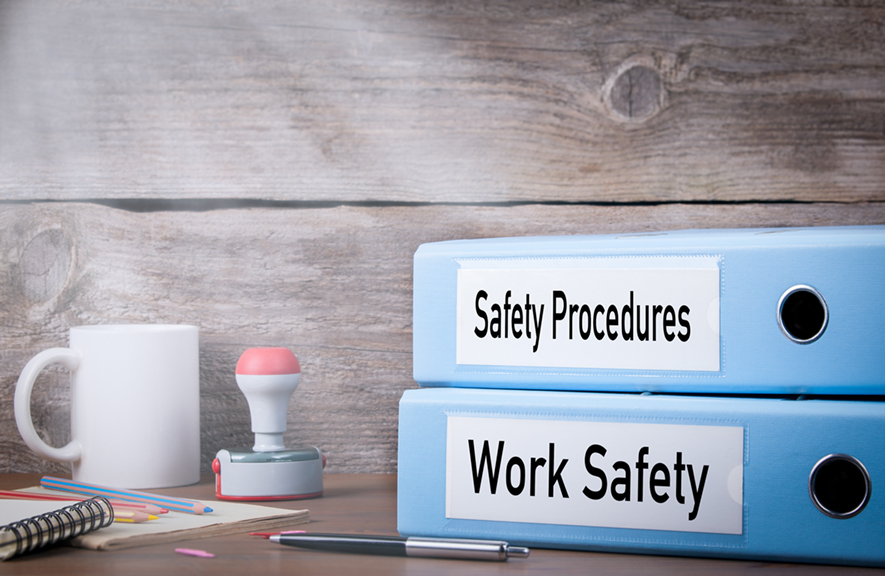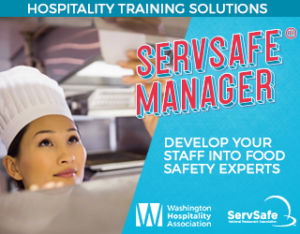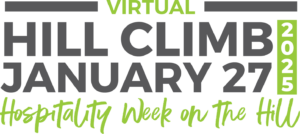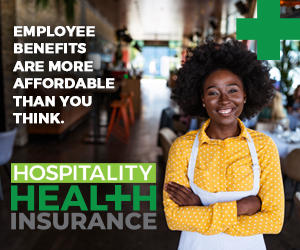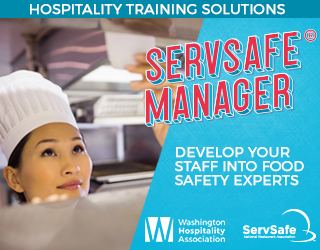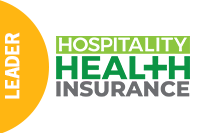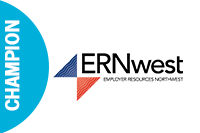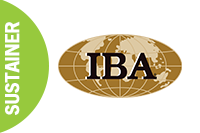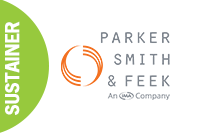By Paul Schlienz
Unfortunately, accidents happen and when they occur in the workplace they can have long-lasting repercussions for the employer as well as the employee.
Washington Hospitality Association members, through our RETRO program and on their own, are going the extra mile to reduce their employees’ safety risks.
Doing the right thing the right way
One of the most important steps an employer can take to prevent worksite mishaps is to have an effective, up-to-date Accident Prevention Program (APP).
[expander_maker id=”1″ more=”Read more” less=”Read less”]
The Department of Labor and Industries requires employers to have a formal, written APP to address potential workplace hazards. The purpose of an APP is to identify these possible hazards and develop solutions to remove or control them before they happen.
An important part of this is developing, supervising, implementing and enforcing safety and health training programs that are effective in practice.
“It’s all about safety and ensuring your employees are being safe,” said Jenny Walker, RETRO key accounts manager with the Washington Hospitality Association. “It’s about being proactive. It’s the law that you need to have a plan that is tailored to each of your locations in Washington.”
Having identified workplace hazards, the next step is to find and apply ways to reduce or eliminate hazards by providing detailed safety orientations to employees to help them remain safe on the job.
In addition to APPs, other health and safety program requirements may apply to your business depending on the activities and hazards in your workplace. Employers in Washington, for example, are required to have, depending on the number of employees, either safety meetings or a safety committee.
Unfortunately, many employers are either not clear about what they need to do or simply overlook these obligations.
“Employers tend to get caught up in day-to-day business and neglect to do walkthroughs of the premises and ask their employees if physical hazards exist,” said Steve Wazny, owner of AJP Enterprises, which operates 48 Arby’s, 47 Jack in the Boxes and seven Jimmy John’s.
Jaime Fox, director of training and development at Hop Jack’s, a restaurant and bar chain with locations in Washington and Oregon, seconded that. “Almost everything that can affect the safety of the team can be overlooked. It’s important for leadership to keep focused on it,” she said.
Walker noted that some restaurants and hotels are unaware that they are required to have regular work safety meetings or safety committees (see page 21).
“Before I go on an onsite walk through, I always go through the APP with the employer, and I let them know how much it would cost if L&I did an inspection and found out they didn’t have a functioning APP,” Walker said. “L&I’s fines are not cheap, and you don’t want to put yourself in the position of having to pay them.”
Zero accidents
Hospitality businesses need to be constantly on the lookout for hazards that could lead to workplace injuries. Most common in our industry are cuts, slips and falls, and injuries related to overexertion. (See pages 23–25 for prevention tips.)
Wazny and his team, for example, carefully examine his company’s statistics on workplace accidents and look for patterns in what types of accidents happen, and where and when they happen.
“We always act proactively,” Wazny said. “We look at accident history and what month different types of accidents are occurring. For example, when rain kicks in during October and November, slips and falls go up because we have more wet floors. We respond by doing things like checking our floor mats. Safety has to be part of your culture, and we monitor each other.”
Wazny and his team also discovered by reviewing their statistics that there was an uptick in hold-up robberies in December during the winter holiday season. Accordingly, each location was trained to respond to this potential threat.
“When we visit with leadership at restaurants, we discuss safety with them,” Wazny said. “I sign off on all safety reports. One of the first questions I ask our managers is if everything is working okay. Inevitably, once I look over the premises, I’ll find something broken and the manager will say they forgot. I’ll see floors more slippery than they should be. I’ll then talk to maintenance people, and we’ll work on reeducating them on properly cleaning floors. It’s all about teaching people to notice potential problems. Accidents will happen, but our goal is zero accidents.”
Hop Jack’s has also been focused on reducing accidents and hazards.
“We made a cultural shift in 2015 to put more emphasis on safety,” said Fox.
The result?
“Hop Jack’s had a dramatic reduction in L&I claims,” said Fox. “In 2016, we had more than $100,000 in L&I claims, but in 2017, even though, by then, we had more restaurants and more employees, our L&I claims were only $10,000.”
According to Fox, Hop Jack’s puts a strong emphasis on safety in its orientation and onboarding of new employees.
“We train new employees in personal protection to keep accidents from happening,” said Fox. “We have safety communication in each location, and our safety committees include a good cross section of employees.”
Like restaurants, hotels also put the focus on addressing potential hazards.
Common injuries at hotels include musculoskeletal strains from reaching and lifting things like mattresses and repetitive motion injuries. Bloodborne pathogens also present risks that require special safety training for employees who are at risk for exposure. This includes employees designated to provide emergency first aid, who clean up garbage and housekeepers.
Falls related to ladders – a major cause of injuries in all industries – are also a risk for hotel employees, as are accidents that can result from electrical work and sprains and strains from lifting.
“We find that the most common injuries we have are back injuries,” said Bonnie Poon, director of payroll, benefits and compliance at InnVentures, which manages hotels in California, Florida, Idaho, Oregon and Washington. “We always have training programs every quarter, so employees can avoid these injuries and others.”
Poon also thinks the safety committees at each of InnVentures’ locations are useful in proactively identifying hazards.
“Our safety committees get together and come up with ideas they think would be helpful,” said Poon. “Every hotel is unique. We, in management, may not see what employees see, so we really like getting the employees’ perspectives.”
Ambassadors for safety
Even with the very best efforts at reducing hazards and training employees to be safe, workplace injuries can still happen.
This is where L&I’s Return to Work program comes in. Return to Work helps your employees get back to work as soon as possible. This can be done by giving your employees shorter hours, doing different work and assigning light duty tasks until they are fully recovered.
“There are two legs to safety programs – what can you do to eliminate all accidents in the first leg,” said Wazny. “The second leg is administrative. One is strategically planning a safety focus for each month, and looking at issues like when you do have an accident, getting your employees back to work as soon as possible. That’s why we like Return to Work.”
Fox, too, is a fan of the Return to Work program.
“If one of our team members is injured, they stay on salary,” said Fox. “We get more team members back to work quicker this way. It shows we care about them, and there’s less turnover with team members who are injured. With this program, they know how important they are to the company. And once they come back, these employees become ambassadors for safety.”
Safety Committee or Safety Meetings?
Worker participation on safety committees or in safety meetings can strengthen your safety culture and help you prevent costly workplace injuries.
In Washington state, a safety committee is required when you have 11 or more employees on one or more work shift. If your business does not meet this threshold, you can choose between having a safety committee or holding safety meetings at least monthly. You must, however, have one or the other. Here are some things to note:
Safety Committees
Make sure your safety committee:
- Has employee-elected and employer-selected members. The number of employee-elected members must equal or exceed the number of employer-selected members. The term of employee-elected members must be a maximum of one year.
- Has an elected chairperson.
- Determines how often, when, and where, the safety committee will meet.
- Takes minutes and preserves minutes for one year for possible review by L&I. Include attendees and subjects discussed.
- Meetings are one hour or less, unless extended by a majority vote of the committee for improvement, if needed.
Safety Meetings
Make sure your safety meetings:
- Are held monthly. You may meet more often to discuss safety issues as they come up.
- Have at least one management representative.
- Record who attends and the topics discussed.
Both committees and meetings should:
- Review safety and health inspection reports to help correct safety hazards.
- Evaluate the accident investigations conducted since the last meeting to determine if the cause(s) of the unsafe situation was identified and corrected.
- Evaluate your workplace accident and illness prevention program and discuss recommendations for improvement, if needed.
TIPS FOR EFFECTIVE SAFETY MEETINGS
Get prepared. Pick safety topics that are relevant to the particular workplace. Ideas can come from observations made during a recent safety walk-around.
Be creative. Consider using hands-on activities like demonstrations and include resources like safety handouts and short videos that offer compelling, real-life stories and important injury prevention tips. Search the A-Z list of safety and health topic pages at www.Lni.wa.gov/Safety for materials.
RESOURCES
Washington Hospitality’s Return to Work Guide for Restaurants and Hotels
Your guide to offering proactive light-duty measures.
Washington Department of Labor and Industries Stay at Work Program
www.lni.wa.gov/main/stayatwork
Under this program, L&I reimburses eligible employers for some of their costs when they provide temporary, light-duty jobs.
Washington Hospitality Association Education Foundation
Onsite training for bloodborne pathogens, CPR, AED, First Aid, incipient firefighting and hazardous communications training to help you proactively reduce the risk or the impact of a workplace injury.
Washington Hospitality Association RETRO
www.wahospitality.org/wise-buy/retro
The Association’s retrospective rating program is the third largest in the state and helps members work safe to save money.
Our partner Employer Resources Northwest (ERNwest) helps participating members navigate the claims process, and our in-house Retro team can walk you through the Return to Work process. Call 800-225-7166 for more information.
[/expander_maker]




